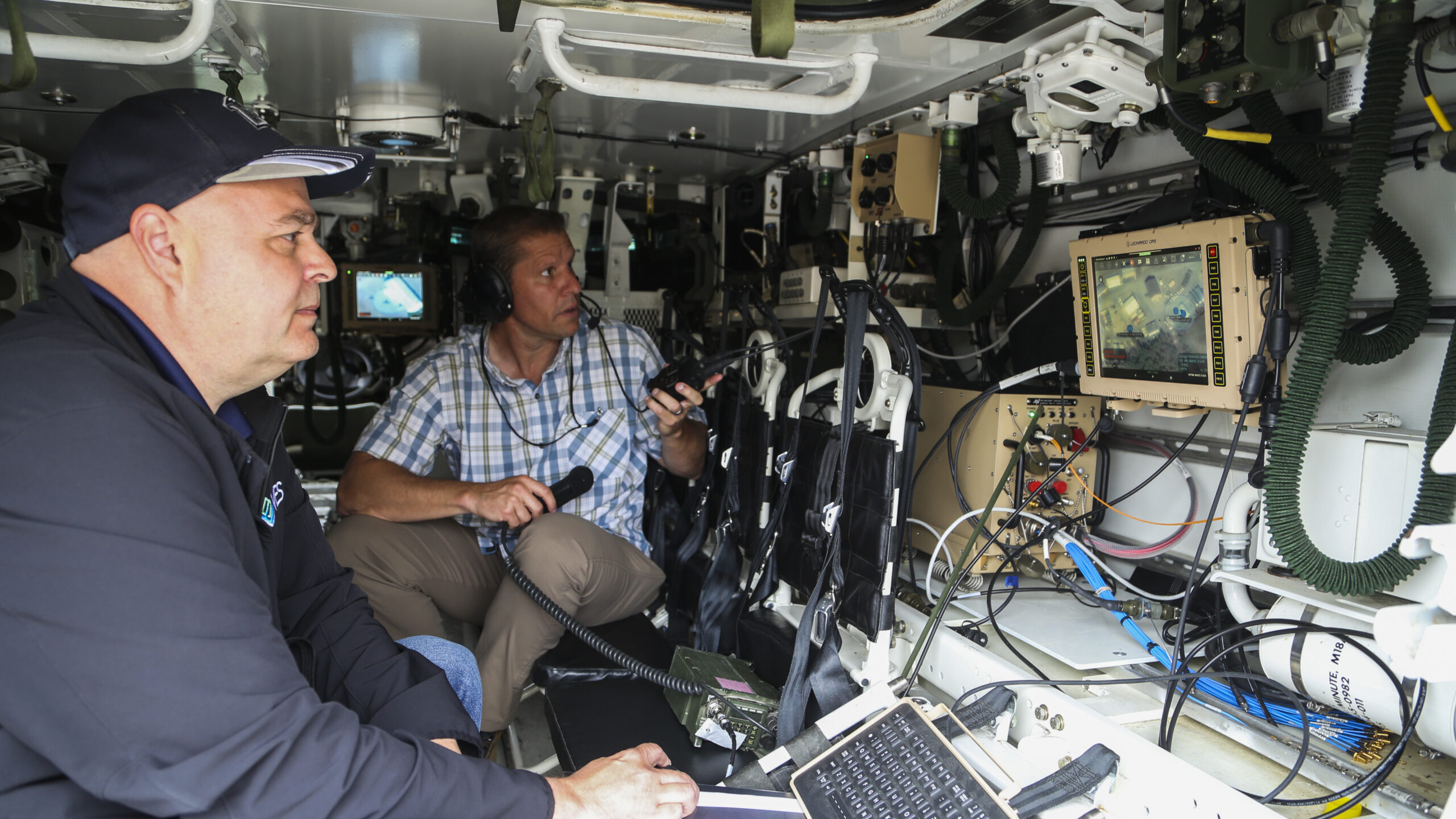
C5ISR Center scientists and engineers continued their work as they assessed emerging government and industry positioning, navigation and timing technologies, along with testing the C5ISR/Electronic Warfare Modular Open Suite of Standards (CMOSS) chassis, during the Network Modernization Experiment (NetModX 21). (Kaitlin Newman/US Army)
WASHINGTON: The Army’s network research team and science and technology community just wrapped up nine weeks of experiments, involving communications tech that could be used on the service’s high-profile next-gen helicopters and will help inform its ongoing Joint All Domain Command and Control efforts.
During the fourth annual Network Modernization Experiment, or NetModX, at Joint Base McGuire-Dix-Lakehurst in New Jersey, the Army’s Network Cross-Functional Team (CFT), its C5ISR Center and the science and technology community, including industry vendors, all came together to look at ways to improve the service’s acquisition and S&T investments and examine what’s coming out of them.
“NetModX is a great testbed for us to kind of understand how our investments are working out as they graduate from a lab setting and make adjustments as needed to be able to get the most value out of those investment areas that we have,” Joseph Welch, director of the C5ISR Center, told reporters Thursday.
This year’s experiment included over 36 different technologies and focused on exploring automated and protected communications in contested battlefields. It also dealt with aspects of the Future Vertical Lift program, one of the service’s 35 modernization priorities, Welch said.
The C5ISR Center is working on the Relay for Aerial Non-line-of-sight Ground Environment, or RANGE, an aerial tier networking program to develop a “transformative tactical radio relay capability,” James Tucker Swindell, chief of the radio frequency communications division at the C5ISR center said.
“We’re pushing for high throughput non-line-of-sight tactical [communications], providing resilient options for communications-denied environments, all while incorporating the modular form factor for” unmanned aircraft systems, Swindell said. The “reason why we’re doing that is if you build it for a UAS, when you scale up for manned aircraft, it’s a lot easier to build that direction than the reverse.”
He added RANGE’s modular nature is meant to allow change with “the speed of need” by instead of ripping an entire system out of an aircraft, “you can simply change a card.” This will eliminate having to go back to the initial vendor and save time and money for the service. The first deliverable out of RANGE is targeted for fiscal 2026.
According to an April 18 Army press release, the RANGE team is working hand-in-hand with the Future Vertical Lift Cross-Functional Team “to provide analysis and integration of communications links from UAS systems to the ground and FVL assets to allow for data transfer.”
Talking In The Face Of Interference
Thomas Harvey, an electrical engineer and field exercise coordinator for Modular Radio Frequency at the C5ISR Center, said his team at NetModX this year experimented with radio frequencies in an environment “involving RF interference conditions.” They looked at capabilities like data duplication, where traffic was sent across multiple transports with the goal of reducing network switching time.
“We also looked at dynamic routing, which increased the network resiliency,” Harvey said. “Traffic prioritization is also something we looked at, sending… multiple traffic flows, which optimizes the quality of the higher priority traffic flow compared to the lower priority traffic flow when conditions were contested and congested.”
The Network CFT is also using the annual experiment to assess technologies that can be included in its capability sets, which are tool kits of applications and technologies designed to modernize network capabilities across the service every two years. Currently, the Army is developing its third and fourth capability sets, Capability Sets 25 and 27.
RELATED: Ukraine Invasion ‘Reinforcing’ Army’s Work On Secure Networks, Comms
Beyond 25 and 27, Tyler Barton, a computer scientist at the C5ISR Center, told reporters his team is targeting technologies for Capability Set 29. Without divulging which specific technologies are under consideration, Barton said the service invited industry to bring their solutions to NetModX with the end goal of having a “full mesh capability” for better resiliency.
“We had several systems we looked at from vendors, we exercised them at various ranges, looked at normal network performance characteristics like… latency and throughput,” said Barton, who leads the team responsible for developing a mobile and survivable command post. “We also looked at the network topology. We’re shooting for a mesh network for better resiliency… . We looked at some more command post-specific considerations like how they perform penetrating through foliage, penetrating through camouflage that the commanders would be covered with and we looked at some characteristics that are unique to the Army.”
The service has been working to develop new mobile command centers through different efforts like the Command Post Integrated Infrastructure System, which can be set up quicker than older systems and operate in a dispersed manner, and the Command Post Computing Environment, a centralized mission command suite consisting of a group of servers and software.
The experiment also served as a “key part” of Project Convergence, the Army’s signature JADC2 effort, Brig. Gen. Jeth Rey, director of the Network CFT, told reporters. This year, the experiment specifically helped to inform efforts to expand the network to provide increased connectivity to ground forces.
RELATED: Networks As ‘Center Of Gravity’: Project Convergence Highlights Military’s New Battle With Bandwidth
“Coming out of Project Convergence 21, we really saw how the aerial tier could extend our network, but we wanted to do some further evaluations and NetModX was able to help us in that and now we’re going to introduce it back into Project Convergence 22 which will allow us to potentially take it further and get it into the hands of our soldiers…That really helps us improve our modernization efforts when it comes to our capabilities,” Rey said.
The next Project Convergence is slated to take place in around October this year and will be a joint venture involving the Army’s coalition partners.






















